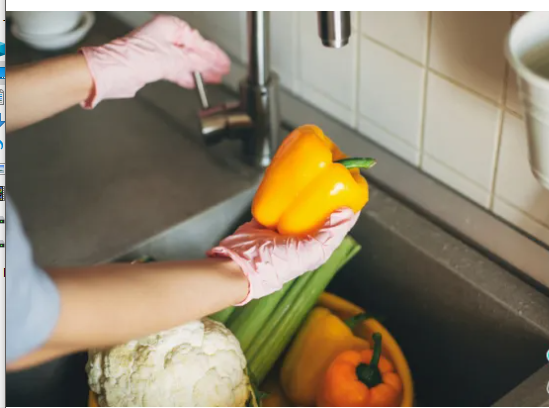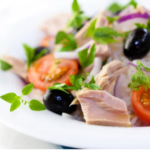Whenever we consume fruits and vegetables, it is essential to wash and disinfect them properly, since there are pathogens and chemical elements that could contaminate these foods. However, with the current situation of the coronavirus pandemic, these measures must be even more extreme. Neglecting the hygiene of the vegetables that we consume can cause us different diseases, some very annoying and others extremely dangerous. Washing vegetables only with water does not guarantee their disinfection, exposing us to all kinds of microbes, such as viruses and bacteria. For all this, we share all the details of how to disinfect vegetables at home.
 How to wash vegetables?
How to wash vegetables?
Although there are clear differences between vegetables, given the characteristics of each type of vegetable, when it comes to sanitizing there are certain basic rules that apply to all of them equally and that you should always follow:
- Wash your hands very well. Wash them with soap and water for 20 seconds.
- Thoroughly clean the work surface and the utensils that you will use. For example, the table, knife, board, colander, etc.
- Acquire a special brush for each type of vegetable. For vegetables with hard skins, like squash, use a large, strong-bristled one. For vegetables with more delicate skin, such as cucumber, aborigine, zucchini, etc., use a medium soft bristle brush. Finally, there are the tubers, to these assign a medium brush with intermediate bristles.
- Have an exclusive table for vegetables. If you use the same table for all foods, you risk cross-contamination. Designate a table for each thing: one for vegetables, another for bread and pastries, one for meat and one for fish. Avoid boards with a very porous texture.
- Use some antiseptic to disinfect the boards. In these times of pandemic, the most recommended is bleach for food use, although there are many others that you can prepare at home. To use it, pour a solution of 1 liter of water per 1 tsp. of food bleach into a large bowl. Remember that the label must indicate that chlorine is used to purify water and sanitize food, if you use common chlorine it will not work, as it is toxic.
Some special measures during the pandemic
Although Covid-19 is not spread through food, some precautions never hurt. So when you get home from shopping, disinfect the vegetable packages with a vaporizer containing a solution of alcohol and water and let it act for a few minutes (5 minutes). Then, using kitchen paper, dry them to finish cleaning them (use a new towel for each package and throw it away when finished). Eliminate unnecessary packaging (if the fruit can be kept well without it, throw it away) and leave only the essential ones.
Once the previous part is finished, wash all the vegetables under the tap water and prepare the solution of water and chlorine. Submerge the vegetables in the water and let them sit for 3-5 minutes. After this time, drain and dry the vegetables very well to store them (make sure they are very dry or they can be damaged). Wear gloves, cover your mouth and wash your hands constantly every time you finish cleaning a food.
Sanitizers for washing vegetables
After reviewing the basic rules for washing vegetables correctly, we are going to see which are the best disinfectants to eliminate any microorganism from this food. All of them are good for all types of vegetables, so you can choose one or the other depending on your preferences or what you have at home at that time.
How to disinfect vegetables with chlorine or bleach?
Chlorine or food bleach is an excellent disinfectant due to its incredible effectiveness. Remember to make sure you use the food option and not the domestic one. The ratio is this:
- 1 liter of water for 1 teaspoon of chlorine or food bleach
How to disinfect vegetables with vinegar?
One of the best natural disinfectants to wash vegetables and fruits is vinegar, both white and apple. You just have to mix equal parts water and vinegar and submerge the food in the solution. The amount will depend on the total number of vegetables that you must disinfect.
How to disinfect vegetables with lemon?
Lemon is another perfect product to disinfect vegetables naturally due to its antimicrobial properties. The recommended ratio is:
- Maximum 1 liter of water per half liter of lemon juice, ideally 1/4.
How to disinfect vegetables with baking soda?
We finish the list of the best disinfectants for washing vegetables with baking soda, another powerful antiseptic. Follow this ratio:
- 1 liter of hot water for 2 teaspoons of baking soda.
Next, we explain the times and other recommendations depending on the type of vegetable.
How to wash green leafy vegetables?
Lettuce, spinach, chard and many others need special treatment when washed so as not to wither and leave them well sanitized. The steps are not very complicated and here we explain how to wash green leafy vegetables:
- Strip the vegetable. Take the leaves out very carefully to avoid breaking or mistreating them.
- Submerge them in water with some antiseptic. Put them in a large and deep bowl; add the natural disinfectant of your choice.
- The soaking time should not exceed 15-20 minutes. After that time, he rubs the leaves with his hands, one by one, very gently so as not to mistreat them. Does this until you feel no trace of dirt or any dirt?
- Rinse them very well with plenty of water.
- Remove dark or wilted leaves.
- Drain the leaves and dry them very well. Pass them through the strainer and dry them with kitchen paper (preferably absorbent), ready to be seasoned!
How to disinfect tubers and roots?
Although this type of vegetable (potatoes, carrots, radishes, ginger, etc.) is customary to cut before washing and then clean it already peeled (directly under tap water), this procedure is incorrect and unhealthy. Why? Because these foods usually bring with them remains of soil and fertilizer, which contain microorganisms that can make us sick. Perhaps many times we do it this way and nothing happens, but we run an important risk unnecessarily. In addition, properly sanitizing the tubers is nothing to write home about and you can check it out below:
- Never peel vegetables before washing them. If you cut the vegetables directly, without cleaning them first, you transport the microorganisms that are on the outside to the knife and from there they go inside the food and contaminate it.
- Submerge the tubers in a bowl with some disinfectant and water. Although some people think that brushing and washing the tubers is enough, it is always better to also disinfect them, especially in these times. Leave them there for 15-20 minutes.
- Clean these vegetables thoroughly with a brush. Use the most suitable brush for them, remove all the dirt or dust and rinse them with plenty of water.
- Rinse them very well under running water.
- Drain them and dry them with paper. After drying them, you can now cut them or store them.
If potatoes are the type of vegetable that you are going to disinfect, do not forget to check our recipes with this ingredient:
- Potato straws
- Potato parmentier
- Garlic Potatoes
How to sanitize cruciferous vegetables?
The family of vegetables called cruciferous (cauliflower, broccoli, cabbage, Brussels sprouts, cabbage, turnip greens, turnip greens, radishes, mustard greens, kale, etc.) is represented by vegetables with a fragile structure, which house many spaces where they can be hide bugs. Generally, many of these vegetables look like a miniature forest, full of small trees, and others resemble a flower bud or onion, since they have many layers. For this reason, we commonly think that they are very difficult to wash. However, it is not that complicated and everything is summarized in the following simple steps:
- Wash cruciferous vegetables according to their characteristics. Those with leaves can be disinfected in the same way as green leafy vegetables. Those that are made up of bouquets will need to be washed using the next step.
- Separate into bunches. If the vegetable is small, separate the bouquets and if they are still very large, cut them. For large cruciferous vegetables, cut them in half and then separate them into small trees, just the size you want to eat.
- Remove the core or cut it. Remove the center or trunk or cut it into small pieces to disinfect them just like the rest of the vegetable.
- Submerge the bouquets in a bowl with water and the chosen disinfectant. Stir them in the water and leave them there for 15-20 minutes. Don’t let them float. To prevent this from happening, place a flat plate on top, slightly smaller than the bowl, and put something heavy on it.
- Remove the water and rinse the pieces very well under cold running water. After the stipulated time has passed, you will see how the remains of dirt come to the surface.
- Drain and dry. Pass the pieces through a strainer and dry them with kitchen paper, they are ready to be included in any recipe! One of the best ways to eat this type of vegetables is by cooking them in the oven, and for this we advise you to consult the baked cauliflower with cheese recipe.
How to wash vegetables with skin?
In the case of vegetables with a softer skin and that are usually eaten, such as zucchini, aborigine or cucumber, the disinfection technique is the same as that used with tubers and roots. However, when scrubbing these soft-skinned vegetables, you’ll need to use a brush with softer bristles and treat them more gently.
How to disinfect mushrooms?
Washing mushrooms is very simple but somewhat tedious. To clean this type of vegetables you must also apply the same procedure that you use with the tubers, although with more meticulousness. It is important that you clean this vegetable in detail, as it has a structure with many holes that can pick up small microorganisms, remains of earth, etc.



